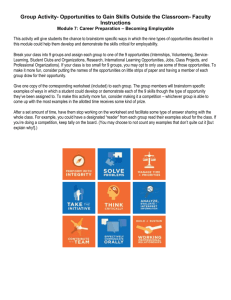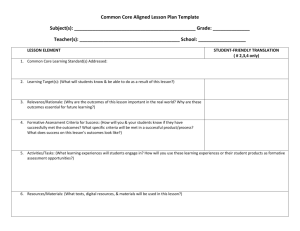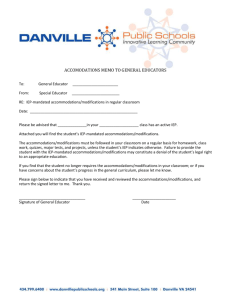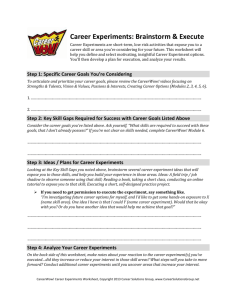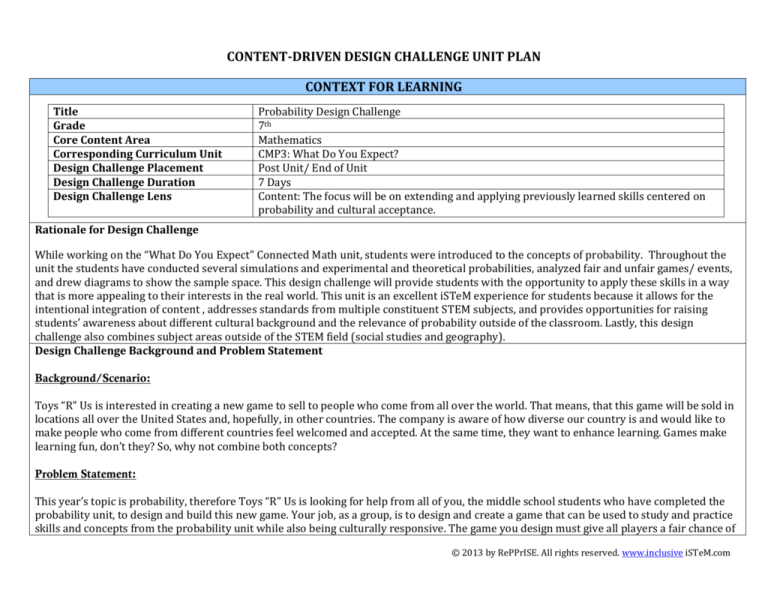
CONTENT-DRIVEN DESIGN CHALLENGE UNIT PLAN
CONTEXT FOR LEARNING
Title
Grade
Core Content Area
Corresponding Curriculum Unit
Design Challenge Placement
Design Challenge Duration
Design Challenge Lens
Probability Design Challenge
7th
Mathematics
CMP3: What Do You Expect?
Post Unit/ End of Unit
7 Days
Content: The focus will be on extending and applying previously learned skills centered on
probability and cultural acceptance.
Rationale for Design Challenge
While working on the “What Do You Expect” Connected Math unit, students were introduced to the concepts of probability. Throughout the
unit the students have conducted several simulations and experimental and theoretical probabilities, analyzed fair and unfair games/ events,
and drew diagrams to show the sample space. This design challenge will provide students with the opportunity to apply these skills in a way
that is more appealing to their interests in the real world. This unit is an excellent iSTeM experience for students because it allows for the
intentional integration of content , addresses standards from multiple constituent STEM subjects, and provides opportunities for raising
students’ awareness about different cultural background and the relevance of probability outside of the classroom. Lastly, this design
challenge also combines subject areas outside of the STEM field (social studies and geography).
Design Challenge Background and Problem Statement
Background/Scenario:
Toys “R” Us is interested in creating a new game to sell to people who come from all over the world. That means, that this game will be sold in
locations all over the United States and, hopefully, in other countries. The company is aware of how diverse our country is and would like to
make people who come from different countries feel welcomed and accepted. At the same time, they want to enhance learning. Games make
learning fun, don’t they? So, why not combine both concepts?
Problem Statement:
This year’s topic is probability, therefore Toys “R” Us is looking for help from all of you, the middle school students who have completed the
probability unit, to design and build this new game. Your job, as a group, is to design and create a game that can be used to study and practice
skills and concepts from the probability unit while also being culturally responsive. The game you design must give all players a fair chance of
© 2013 by RePPrISE. All rights reserved. www.inclusive iSTeM.com
winning and be influenced by the cultural backgrounds of those designing the game.
LEARNING OUTCOMES
Big Ideas/Enduring Understandings:
Probability is used in the real world, even within games.
Probability can be used to solve real world problems.
Design is a process that is multi step and requires revision and redesign.
The engineering design process can be used to solve real world problems and create new technologies.
CONTENT AREA Learning Objectives
(Students will know and be able to…)
Essential Questions and Understandings
Students will be able to…
Determine if a game is fair using laws
of probability
Write probability questions and
answers
Students will know...
Probability is a way to analyze possible
outcomes.
Theoretical probability versus
experimental probability.
PROCESS Independent Learner Objectives
CORRESPONDING STANDARDS
(Students will know and be able to…)
Tech Essential Questions & Understandings
Students will be able to…
Math Standards:
Apply a design process to solve a
7.SP.5 - Understand that the
given problem.
probability of a chance event is
a number between 0 and 1 that
Brainstorm as a group problemexpresses the likelihood of the
solving design process in which each
event occurring. Larger
person in the group presents his or
numbers indicate greater
her ideas in an open forum.
likelihood. A probability near
Make two-dimensional and threeindicates an unlikely event, a
dimensional representations of the
probability around 1/2
designed solution.
indicates an event that is
Test and evaluate the design in
neither unlikely nor likely, and
relation to pre-established
a probability near 1 indicates a
requirements, such as criteria and
likely event.
constraints, and refine as needed.
7.SP.6 - Approximate the
probability of a chance event by
Students will know...
collecting data on the chance
Design is a creative planning process
process that produces it and
that leads to useful products and
observing its long-run relative
systems.
frequency, and predict the
Requirements for design are made up
approximate relative frequency
of criteria and constraints.
© 2013 by RePPrISE. All rights reserved. www.inclusive iSTeM.com
The steps of the design process.
given the probability. For
example, when rolling a number
cube 600 times, predict that a 3
or 6 would be rolled roughly 200
times, but probably not exactly
200 times.
7.SP.7 - Develop a probability
model and use it to find
probabilities of events.
Compare probabilities from a
model to observed frequencies;
if the agreement is not good,
explain possible sources of the
discrepancy.
a. Develop a uniform
probability model by assigning
equal probability to all
outcomes, and use the model to
determine probabilities of
events. For example, if a student
is selected at random from a
class, find the probability that
Jane will be selected and the
probability that a girl will be
selected.
b. Develop a probability model
(which may not be uniform) by
observing frequencies in data
generated from a chance
process. For example, find the
approximate probability that a
spinning penny will land heads
up or that a tossed paper cup
will land open-end down. Do the
outcomes for the spinning penny
appear to be equally
likely based on the observed
© 2013 by RePPrISE. All rights reserved. www.inclusive iSTeM.com
frequencies?
7.SP.8 - Find probabilities of
compound events using
organized lists, tables, tree
diagrams, and simulation.
a. Understand that, just as with
simple events, the probability of
a compound event is the
fraction of outcomes in the
sample space for which the
compound event occurs.
b. Represent sample spaces for
compound events using
methods such as organized lists,
tables and tree diagrams. For an
event described in everyday
language (e.g., “rolling double
sixes”), identify the outcomes in
the sample space which
compose the event.
c. Design and use a simulation
to generate frequencies for
compound events. For example,
use random digits as a
simulation tool to approximate
the answer to the question: If
40% of donors have type A
blood, what is the probability
that it will take at least 4
donors to find one with type A
blood?
Technology Standards:
Standard 8: Students will
develop an understanding of
the attributes of design
Standard 9. Students will
develop an understanding of
© 2013 by RePPrISE. All rights reserved. www.inclusive iSTeM.com
engineering design.
Standard 10. Students will
develop an understanding of
the role of troubleshooting,
research and development,
invention and innovation, and
experimentation in problem
solving
Standard 11. Students will
develop the abilities to apply
the design process.
ASSESSMENT
DIAGNOSTIC
Pre-test
Previous Quiz or Test
Universal Screening/District
Common Assessment
Summative assessment from a
previous activity
Mind Map
Anticipation Guide
Previous self-assessment
Conference/Interview
Survey/Questionnaire
FORMATIVE
SUMMATIVE
Individual:
Signaled Response (e.g., whiteboard, traffic
light card, thumbs up/middle/down, etc.)
Observation + Anecdotal notes
Differentiated Quiz, Entry, or Exit Ticket
Journal entry/Response log/Inventor’s
notebook
Graphic organizer (venn, t-chart, map)
Plan, Sketch, or Diagram
Portfolio artifact (sketch, morph chart, etc.)
Peer-Assisted:
Analyze anonymous peer work
Think-Pair-Share
Peer/Self Assessment
Give one-Get one
Peer conference (includes structured
documentation)
Small Group:
Criteria development
Paper-Based:
State assessments
District benchmark or interim
assessments
End-of-unit or chapter tests
End-of-term or semester exams
Final Portfolio
Report
Poster
Data Display
Brochure/Pamphlet
Survey
Self Assessment
Performance-Based:
Multi-media presentation
Oral Presentation
Performance/Demonstration
Model/Prototype
Working Model/Prototype
System/Machine
© 2013 by RePPrISE. All rights reserved. www.inclusive iSTeM.com
Heads together
Ambassadors
Model development
Practice presentation
Panel Discussion
Exhibition of Products
Video
Website
Whole Group:
Question and Answer Sessions (with charted
documentation)
Agreement circles
© 2013 by RePPrISE. All rights reserved. www.inclusive iSTeM.com
DESIGN BRIEF
Background
& Problem
Statement
Background/Scenario:
Toys “R” Us is interested in creating a new game to sell to people who come from all over the world. That means, that
this game will be sold in locations all over the United States and, hopefully, in other countries. The company is aware of
how diverse our country is and would like to make people who come from different countries feel welcomed and
accepted. At the same time, they want to enhance learning. Games make learning fun, don’t they? So, why not combine
both concepts?
Problem Statement:
Criteria
This year’s topic is probability, therefore Toys “R” Us is looking for help from all of you, the middle school students who
have completed the probability unit, to design and build this new game. Your job, as a group, is to design and create a
game that can be used to study and practice skills and concepts from the probability unit while also being culturally
responsive. The game you design must give all players a fair chance of winning and be influenced by the cultural
backgrounds of those designing the game.
A viable solution to the problem must meet the following requirements:
Designing the game:
It can be any game that can be sold at Toy’s “R” Us.
The game must include precise rules and directions.
Your game must have a name.
The game must be able to be played during class time.
Must be inspired or influences by the cultural backgrounds of the group members.
There must be a winner of the game.
Once you have invented a new game as an idea and sketch, you must make the game functional:
It must be played without any glitches.
You must make the game using the materials and tools provided.
It must have an appealing look that is inspired by the cultural backgrounds of the group.
Probability:
Theoretical probability – each player playing the game must have a fair chance of winning.
Your game must include at least 20 questions based on the skills and concepts from the probability unit and
their answers.
© 2013 by RePPrISE. All rights reserved. www.inclusive iSTeM.com
Constraints
Materials
Tools/ Machines
o Construction Paper – small &
large
o Paper Clips, Push Pins, etc.
o Recycled Materials (cardboard,
paper towel rolls, etc.)
o Glitter, Pipe Cleaners
o Paint
o Wood – recycled/non-recycled
o Stickers
o Etc.
Student
Deliverables
Understand the
Problem
Research &
Brainstorm
o
o
o
o
o Scissors
o Rulers
o Hole punch
o Hammer
o Pliers
o Sandpaper
o Hand saw
o Exacto razor
o Scroll saw
o Hot glue gun
o Hot wire foam cutter
o Hand drill
Understanding the Design Brief
Rules and Procedures
Research topics
Brainstorm ideas
Other
o At least 4 students per group
o Each group member is responsible
for his or her work.
o Each group is responsible for
maintaining a clean and safe work
environment.
o Teacher and other adults will be
available to answer questions and
provide assistance.
Design & Build
o Rough Sketches
o Final sketch and rationale
o Finished game
Test &
Redesign
o Reflection and Redesign
o Play your own game.
Present
o All documents from the Design Challenge (Completed Portfolio)
o Playing games created by other groups. (Rating games from other groups)
© 2013 by RePPrISE. All rights reserved. www.inclusive iSTeM.com
Plan for Instructional Delivery
Step One: Understand the Problem
Pacing: 1 period (42 minutes)
Engage/Explore (Before)
Explain/Elaborate (During)
Evaluate/Extend (After)
Lesson 1: Day 1
Lesson 1: “Engineering Design Process”
Lesson 1:
Students will be:
o Given a sheet of rules and procedures
o Placed in cooperative groups
o Reviewing the engineering design
process.
Students will:
o Review the rules and procedures for the
duration of the design challenge.
o Review the engineering design process
using the Think-Pair-Share. First students
will independently work on the
worksheet. Following, they will turn to a
partner to share and discuss their
answers.
Teachers will:
o Provide positive and corrective
feedback.
o Reveal the engineering design
process poster that will be in the
classroom for the remainder of the
year.
Lesson 2: Day 1
Students will be given the design brief and the
“Understanding the Design Brief” worksheet.
Lesson 2: “Understanding the Design Brief”
Students will:
o Use the scripted cooperation method to read
and discuss the design brief
A student will read a section of the design
brief to the class. One member from each
group will summarize what was just read.
The student who summarizes will rotate as
each section of the design brief is read out
loud to the class.
o Complete the Understanding the Design Brief
worksheet and compare answers with their
group members.
Students will complete their engineering
design process worksheet in order to move
on to “Understanding the Design Brief”
Lesson 2: “Understanding the Design Brief”
Teachers will:
o Facilitate the activity and guide
students as needed.
o Review the Understanding Design
Brief once all groups have
completed the worksheet.
Students will complete their
“Understanding the Design Brief”
worksheet in order to move on to Research
and Brainstorm step of the design process.
© 2013 by RePPrISE. All rights reserved. www.inclusive iSTeM.com
Ensure Access:
Elements of Universal Design
Provide Multiple Means of Representation
3.1 Activate or supply background
knowledge
Provide Multiple Means of Action and
Expression
5.2 Use multiple tools for construction
and composition
Provide Multiple Means of Engagement
8.1 Heighten salience of goals and
objectives
Individual Modifications/Accommodations
Modifications:
Individual modifications will be based on
student IEPs and needs.
Accommodations:
Individual accommodations will be
based on student IEPs and needs.
Co-Teaching Strategies
Parallel Teaching
Alternative Teaching
Station Teaching
Team Teaching
One Teach/One Observe
One Teach/One Assist
NOTES:
Step Two: Research & Brainstorm
Pacing: 4 periods (168 Minutes)
Engage/Explore (Before)
Explain/Elaborate (During)
Evaluate/Extend (After)
Lesson 1: Day 1
Lesson 1: “Research”
Lesson 1:
Teachers will review the Understanding Design
Students will:
o Conduct research that will guide students to
think of ideas for their game.
o Collaborate with one another to determine
what to research.
o Complete the research and Brainstorm
worksheet.
Teachers will:
o Circulate and monitor students’
activity.
o Provide guided questioning as
needed.
Brief once all groups have completed the
worksheet.
Students will begin the research step of the
design challenge.
Lesson 2: Day 2
Students will be given the brainstorm
worksheet, “How to Play the Game”
Lesson 3: Day 2/3
Students will be given the “All About
Probability” worksheet.
Lesson 2: “Brainstorm: How to Play the Game”
Part 1
Students will:
o Collaborate with one another in order to
create the rules and directions for their
games. First they will work with a partner to
discuss the directions. Secondly, they will
Students will:
o Gather all materials and clean their
desks.
o Complete an exit slip.
In your own words, what is the
problem you need to solve?
How does this design challenge
relate to the probability unit we
have just completed?
What is the next step of the
© 2013 by RePPrISE. All rights reserved. www.inclusive iSTeM.com
come together as a group to make a final
copy of the rules and directions.
Lesson 3: “Brainstorm: All About Probability” Part
2
Students will:
o Individually create/ develop 5 questions
based on probability that will be
incorporated in their games.
o Collaboratively edit their questions and
choose the final 20 questions.
engineering design process?
As a homework assignment, each student
is accountable for bringing in at least two
materials and/or tools that will be needed
for their game and for completing the
“Research and Brainstorm” worksheet.
Lesson 2:
Teachers will:
o Circulate and monitor students’
activity.
o Check and review students’
directions.
Students need to complete this worksheet
before moving on to part 2 of the
brainstorming.
Lesson 3:
Teachers will:
o Circulate and monitor students’
activity.
o Check and review students’
questions as they complete them
and return to students for
corrections
Students will correct their “All About
Probability” worksheet in order to begin
designing their games.
© 2013 by RePPrISE. All rights reserved. www.inclusive iSTeM.com
Ensure Access:
Elements of Universal Design
Provide Multiple Means of Representation
3.2 Highlight patterns, critical features,
big ideas, and relationships
Provide Multiple Means of Action and
Expression
6.2 Support planning and strategy
development
Multiple Means of Engagement
8.3 Foster collaboration and
communication
Individual Modifications/Accommodations
Modifications:
Individual modifications will be based on
student IEPs and needs.
Accommodations:
Individual accommodations will be
based on student IEPs and needs.
Co-Teaching Strategies
Parallel Teaching
Alternative Teaching
Station Teaching
Team Teaching
One Teach/One Observe
One Teach/One Assist
NOTES:
Step Three: Design & Build
Pacing: Designing - 3 Periods ( 126 Minutes) Building – 3 periods (126 Minutes)
Engage/Explore (Before)
Explain/Elaborate (During)
Evaluate/Extend (After)
Lesson 1: Day 3
Lesson 1: “Design Process” Part 1
Lesson 1:
Students will be given the worksheets to
individually design their games.
Students will:
o Individually design a sketch and layout of
all components of their games that align
with the rules and directions that were
previously written.
As a homework assignment students will
complete their sketches in order to combine
with their group the next day.
Lesson 2: Day 4
Students will be given one sheet for a final sketch
and rationale.
Lesson 3: Day 5/6
Students will be able to use the material and tools
to begin building their games.
Lesson 2: “Design Process” Part 2
Students will:
o As a group students will combine aspects
from each individual design and create one
final sketch and rational as to why this is
their final sketch for their game.
Lesson 2:
Teachers will:
o Circulate and monitor students’
activity.
o Check and review students’ final
sketches and rationales.
Students will not be able to begin the
building process until the design process is
© 2013 by RePPrISE. All rights reserved. www.inclusive iSTeM.com
Lesson 3: “Building”
completed.
Students will build their games as a group using
their final sketch as a guide and the materials
and tools that are available in the classroom.
Lesson 3:
Teachers will circulate and monitor
students’ activity and assist with building
when necessary.
Ensure Access:
Elements of Universal Design
Provide Multiple Means of Representation
1.1 Offer ways of customizing the
display of information
Provide Multiple Means of Action and
Expression
6.3 Facilitate managing information
and resources
Provide Multiple Means of Engagement
7.2 Optimize relevance, value, and
authenticity
Individual Modifications/Accommodations
Modifications:
Individual modifications will be based on
student IEPs and needs.
Accommodations:
Individual accommodations will be
based on student IEPs and needs.
Co-Teaching Strategies
Parallel Teaching
Alternative Teaching
Station Teaching
Team Teaching
One Teach/One Observe
One Teach/One Assist
NOTES:
Step Four: Test & Redesign
Pacing: 1-2 periods (42-84 minutes)
Engage/Explore (Before)
Explain/Elaborate (During)
Evaluate/Extend (After)
Lesson 1:
Lesson 1: “Testing: Rating Your Own Game”
Lesson 1:
Students will be given a “Rating Your Own Game”
worksheet in order to make sure their games and
rules follow all criteria and specifications.
Students will:
o Play their own games.
o Make sure that their game aligns with the
rules and criteria and specifications of the
design challenge.
Teachers will circulate and monitor
students’ activity and assist when
necessary.
Lesson 2:
Students must complete the testing
© 2013 by RePPrISE. All rights reserved. www.inclusive iSTeM.com
o
Students will be given “Redesigning: What Would
You Change” worksheet to determine how to
make their solution to better and rate their group
partners.
Rate their games ( complete the testing
worksheet)
Lesson 2: “Redesigning: What Would You Change”
Students will:
o Individually completing the worksheet based
of their time spent playing the game.
o Comment on what they would change and
why.
o Rate their group members.
portion before moving on to the redesign.
Lesson 2:
Teachers will circulate and monitor
students’ activity and assist when
necessary.
Ensure Access:
Elements of Universal Design
Provide Multiple Means of Representation
3.4 Maximize transfer and
generalization
Provide Multiple Means of Action and
Expression
6.4 Enhance capacity for monitoring
progress
Provide Multiple Means of Engagement
9.3 Develop self-assessment and
reflection
Individual Modifications/Accommodations
Modifications:
Individual modifications will be based on
student IEPs and needs.
Accommodations:
Individual accommodations will be
based on student IEPs and needs.
Co-Teaching Strategies
Parallel Teaching
Alternative Teaching
Station Teaching
Team Teaching
One Teach/One Observe
One Teach/One Assist
NOTES:
Step Five: Present/ Final Portfolio
Pacing: 1-2 periods (42-84 Minutes)
Engage/Explore (Before)
Explain/Elaborate (During)
Evaluate/Extend (After)
© 2013 by RePPrISE. All rights reserved. www.inclusive iSTeM.com
Lesson 1:
Lesson 1: Present/ Final Portfolio
Lesson 1:
Students will gather all material for the final
portfolio and play other groups games.
Students will:
o Gather all their materials and worksheets
and combine them to make one group
portfolio.
o Play other groups games and rate their
games like previously done with their own
game.
Teachers will collect all final portfolios and
join in on playing games.
Ensure Access:
Elements of Universal Design
Provide Multiple Means of Representation
3.4 Maximize transfer and
generalization
Provide Multiple Means of Action and
Expression
6.4 Enhance capacity for monitoring
progress
Provide Multiple Means of Engagement
9.3 Develop self-assessment and
reflection
Individual Modifications/Accommodations
Modifications:
Individual modifications will be based on
student IEPs and needs.
Accommodations:
Individual accommodations will be
based on student IEPs and needs.
Co-Teaching Strategies
Parallel Teaching
Alternative Teaching
Station Teaching
Team Teaching
One Teach/One Observe
One Teach/One Assist
NOTES:
© 2013 by RePPrISE. All rights reserved. www.inclusive iSTeM.com

